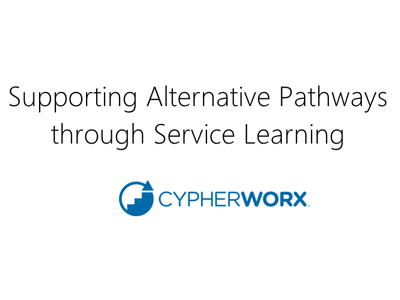 |
Organizational Communication: Innovation and Change |
1.00 |
Innovation is a new idea or process that can change the way organizations operate or think. For an idea or process to be considered an innovation, the majority of people who hear about it must consider it new. Implementation of an idea is not necessary for it to be considered an innovation.
Innovation and change are closely related. When an innovation is adopted, it becomes a change. On the other hand, not all change is innovation. If an innovation is rejected after being adopted, the return to the previous method is not an innovation.
In this course you will learn to: identify degrees and characteristics of innovation, and adopt and encourage innovation, and identify the aspects of change. |
 |
Organizational Communication: Innovation and Change (Instructor Guide) |
1.00 |
Innovation is a new idea or process that can change the way organizations operate or think. For an idea or process to be considered an innovation, the majority of people who hear about it must consider it new. Implementation of an idea is not necessary for it to be considered an innovation.
Innovation and change are closely related. When an innovation is adopted, it becomes a change. On the other hand, not all change is innovation. If an innovation is rejected after being adopted, the return to the previous method is not an innovation.
In this course you will learn to: identify degrees and characteristics of innovation, and adopt and encourage innovation, and identify the aspects of change.
This Instructor's Edition of this course includes notes and suggestions to assist you in presenting the material, whether in an in-person classroom setting, or as an instructor-led online or distance-learning course. It also provides you with the answers to questions found in mid-lesson activities, as well as in the quiz that concludes the course. |
 |
Organizational Communication: Leadership and Motivation |
1.00 |
Organizational communication relies on the communication skills of employees, managers, and leaders. The competence of leaders is reflected in their communication skills. Communication skills also play a major role in differentiating a manager and a leader. To become an effective leader, you need to understand the theories of leadership. The structure of an organization also determines the ability of a manager.
Although motivation resides within an individual, organizations can affect motivation through communication. To motivate employees, management must clearly outline its expectations, goals, and rewards. Organizational structure can affect the communication used to motivate employees, as well as other types of communication within the organization.
In this course you will learn to: describe how communication skills and leadership are related, and define the theories of motivation, and identify motivational tools and the impact of nonverbal behavior. |
 |
Organizational Communication: Leadership and Motivation (Instructor Guide) |
1.00 |
Organizational communication relies on the communication skills of employees, managers, and leaders. The competence of leaders is reflected in their communication skills. Communication skills also play a major role in differentiating a manager and a leader. To become an effective leader, you need to understand the theories of leadership. The structure of an organization also determines the ability of a manager.
Although motivation resides within an individual, organizations can affect motivation through communication. To motivate employees, management must clearly outline its expectations, goals, and rewards. Organizational structure can affect the communication used to motivate employees, as well as other types of communication within the organization.
In this course you will learn to: describe how communication skills and leadership are related, and define the theories of motivation, and identify motivational tools and the impact of nonverbal behavior.
This Instructor's Edition of this course includes notes and suggestions to assist you in presenting the material, whether in an in-person classroom setting, or as an instructor-led online or distance-learning course. It also provides you with the answers to questions found in mid-lesson activities, as well as in the quiz that concludes the course. |
 |
Organizational Communication: Power, Politics, and Diversity |
0.75 |
Power is the ability to influence someone to do something that they would not do without encouragement. Various types of power and power strategies depend on the level of influence. The existence of different levels of power in an organization gives rise to organizational politics.
Politics can arise between individuals who differ from each another. To avoid confrontation arising from differences, it is important for people to recognize the benefits of diversity within their organization.
In this course you will learn to: identify different levels and types of power, identify strategies to manage diversity and to communicate in different cultures, and identify the steps and guidelines for empowerment. |
 |
Organizational Communication: Power, Politics, and Diversity (Instructor Guide) |
0.75 |
Power is the ability to influence someone to do something that they would not do without encouragement. Various types of power and power strategies depend on the level of influence. The existence of different levels of power in an organization gives rise to organizational politics.
Politics can arise between individuals who differ from each another. To avoid confrontation arising from differences, it is important for people to recognize the benefits of diversity within their organization.
In this course you will learn to: identify different levels and types of power, identify strategies to manage diversity and to communicate in different cultures, and identify the steps and guidelines for empowerment.
This Instructor's Edition of this course includes notes and suggestions to assist you in presenting the material, whether in an in-person classroom setting, or as an instructor-led online or distance-learning course. It also provides you with the answers to questions found in mid-lesson activities, as well as in the quiz that concludes the course. |
 |
Organizational Communication: Relational Context and Organizations |
0.75 |
The relational context of a communication exchange includes the circumstances, within an organization, that necessitate this exchange between employees. A number of factors affect the relational context, including the status of the employees within the organization, their motivation, and their relationship with other employees. All communication within an organization depends on the intent of the participants.
In this course you will learn to: identify the relational context and the factors that influence it, and identify the different personality types, and develop individual-organizational relationships. |
 |
Organizational Communication: Relational Context and Organizations (Instructor Guide) |
0.75 |
The relational context of a communication exchange includes the circumstances, within an organization, that necessitate this exchange between employees. A number of factors affect the relational context, including the status of the employees within the organization, their motivation, and their relationship with other employees. All communication within an organization depends on the intent of the participants.
In this course you will learn to: identify the relational context and the factors that influence it, and identify the different personality types, and develop individual-organizational relationships.
This Instructor's Edition of this course includes notes and suggestions to assist you in presenting the material, whether in an in-person classroom setting, or as an instructor-led online or distance-learning course. It also provides you with the answers to questions found in mid-lesson activities, as well as in the quiz that concludes the course. |
 |
Organizational Communication: Technology in the Workplace |
0.84 |
The impact of technology has sped up the communication process in organizations. As a result, communication can occur at any time and place. To facilitate effective communication in an organization, you need to identify and use different communication technologies.
In this course you will learn to: identify the various categories of technologies, identify the impact of technology on organizations, and identify the guidelines for applying technology in an organization. |
 |
Organizational Communication: Technology in the Workplace (Instructor Guide) |
0.84 |
The impact of technology has sped up the communication process in organizations. As a result, communication can occur at any time and place. To facilitate effective communication in an organization, you need to identify and use different communication technologies.
In this course you will learn to: identify the various categories of technologies, identify the impact of technology on organizations, and identify the guidelines for applying technology in an organization.
This Instructor's Edition of this course includes notes and suggestions to assist you in presenting the material, whether in an in-person classroom setting, or as an instructor-led online or distance-learning course. It also provides you with the answers to questions found in mid-lesson activities, as well as in the quiz that concludes the course. |
 |
Organizational Learning: Introduction to Organizational Learning |
0.50 |
This course covers how to describe the fundamental principles of organizational learning. You will also learn how to create an assessment team and assess the knowledge of an organization. |
 |
Organizational Learning: Knowledge Management Systems |
0.50 |
This course covers how to select a knowledge management system. You will also learn how to monitor the elements of a knowledge management system. |
 |
Organizational Learning: Knowledge Transfer |
0.75 |
This course covers how to encourage employees to transfer knowledge and identify and address knowledge transfer reluctance. You will also learn how to use technology for knowledge transfer and identify its challenges. |
 |
Organizational Learning: System Deployment |
0.50 |
This course covers how to develop a pilot project and identify knowledge management leader qualifications and characteristics. |
 |
Organizational Skills: Coordinating Time with Others |
0.50 |
This course covers how to handle visitors and office interruptions. You will also learn how to delegate actively. |
 |
Organizational Skills: Information Management |
0.50 |
This course covers how to identify causes of information overload and manage information by using the INFO process. |
 |
Organizational Skills: Managing Incoming Information |
0.50 |
This course covers how to manage written and oral information. You will also learn how to manage electronic information and use your memory effectively. |
 |
Organizational Skills: Managing Outgoing Information |
0.50 |
This course covers how to manage outgoing information and send written, oral, and electronic information effectively. |
 |
Organizational Skills: Organizing Time |
0.50 |
This course covers how to identify the causes of and remedies for procrastination. You will also learn how to get organized, plan, and prioritize. |
 |
Organizational Skills: Team Time Management |
0.25 |
This course covers how to communicate and plan team time. You will also learn how to identify benefits of managing team time and use team time effectively. |
 |
Organizational Skills: Time Management |
0.25 |
This course covers how to identify characteristics and myths related to time and manage time-related problems. |
 |
OSTPD - Promoting Positive Youth Development |
1.00 |
This training will define Positive Youth Development, benefits of Positive Youth Development and how to implement Positive Youth Development. |
 |
OSTPD - Supporting Alternative Pathways through Service Learning |
1.00 |
This training will cover a number of areas regarding how after school programs can support alternative pathways by using service learning. The course will review what service learning is and provide a solid foundation of this concept. It will then look at the benefits of service learning followed by how service learning supports youth’s alternative pathways. It will conclude with information on how to get started and creating a path to implement service learning in your own program.
|
 |
OSTPD - Supporting Attendance through After School Programming |
1.00 |
This training will cover a number of areas regarding how after school programs can support youth attendance in school. By looking at and exploring the connection between after school programming and attendance in school, we see how after school programming supports attendance at school as well as how to coordinate with the school in order to maximize the positive impact of after school on school attendance through collaboration. |
 |
Outdoor Personal Protective Equipment (PPE) |
0.50 |
Personal protective equipment, commonly referred to as “PPE,” is equipment worn to minimize exposure to various hazards. Examples of PPE include gloves, foot, and eye protection, protective hearing devices (earplugs, muffs), hard hats, respirators, and full-body suits. This course covers protecting yourself from hazardous work-related activities with Personal Protective Equipment. |


























